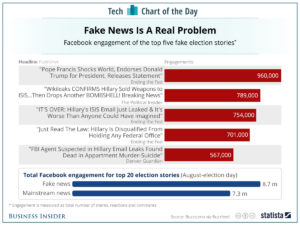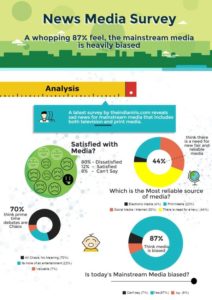
In today’s world, technology connects all of us. In the matter of a second, we could know what is happening in different parts of the world. Precisely because technology is so advanced, we face the issue of having to differentiate between reliable and fake news. Over the past two decades, people have gradually grown sceptical of the news industry. It is a fact that on Twitter, a tweet stating fake news gets more retweets than truthful news. Daily, it’s getting harder to trust the media; which is why it’s of great importance that we don’t fall for news made particularly to deceive us.
What is Fake News?
Fake news is news created to deceive readers. These are usually designed to either influence people’s perspectives or to create confusion. With the rise of digital news, the use of fake news has increased. It is easy for this type of news to become viral. This kind of news could be made up by anyone, which is why it’s often difficult to track its origin.
Fake news often has various impacts on people. Some people might start acting out in fear due to the news about kidnappers in their area or racist thoughts and comments directed at a particular group of people. Not only is this dangerous for us as humans, but it also divides us— those who believe and those who do not.
While there are various reasons to spread fake news— the promotion of an ideology or harming a business competitor— the main reason is that it pays. Popular news creates more advertisement revenue. More clicks on a page, even if the advertisement isn’t clicked on, creates more advertising for the page.
On February 14, 2019, a car bomb hit a convoy of paramilitary police officers in Kashmir. The suicide attack claimed by a Pakistan-based terrorist group killed 40 officers, and social media was flooded by gory media immediately. However, many of these photos and videos weren’t from the attack. A video of an exploding vehicle, supposedly showing the Kashmir bombing, originated in Iraq. Another viral video turned out to be a car bomb in Syria.
What is reliable news?
Reliable news is verifiable content that readers can trust. Here, not only are all the facts checked for but also all errors made are correct. The headlines presented accurately represent the article. They use reputable sources and verify these sources. While the content is verified through many sources, the article is written by the person and isn’t just various points combined to give rise to several paragraphs.
For a journalist to ensure that they are writing a reliable article, they must ensure various things. They need to interview the witnesses, the victims, as well as the accused. They must collect valid evidence and cross-check all the information they have collected. After all these steps have been taken, they have to get it validated.
News Credibility
In today’s times, the credibility of the sources from where the news is gathered is a big question mark. If you are among the ones that follow news updates regularly, you would probably know that every news outlet, be it Indian or international, is inclined towards a particular group of people or a political party. As a result, there is a tendency of propagating that party’s ideologies or propaganda.
If we talk about India in specific, almost all the regional political parties own a newspaper or a channel that would always support them. For instance, the Sun network is owned by DMK in Tamil Nadu and Jaya TV by AIADMK. Similarly, the owner of Sakshi TV happens to be the Chief Minister of Andhra Pradesh, Jagan Mohan Reddy.
On a national front, it is quite evident that news channels like Republic TV, Mirror Now, NDTV, ABP News are among the ones that conduct unnecessary debates and discussions on a large scale instead of using the prime-time for some important news. NDTV’s reason for bias can be very well justified since it is the brainchild of Prannoy Roy and Radhika Roy, sister and brother-in-law of Rajya Sabha MP Brinda Karat who is the wife of CPI(M) General Secretary, Prakash Karat. The newspaper Hindustan Times is managed by Shobhana Bhartiya, a member of Rajya Sabha from Congress till 2012. Likewise, The Pioneer is owned by Chandan Mitra, a two-term BJP member of Rajya Sabha from Madhya Pradesh.
Coming to international news outlets, the scenario is no different. Alternet, The American Spectator, CNN are the ones that top the list of being biased towards some or the other party.
How can we spot fake news?
While the internet has made it easy to create and spread fake news, it has also made it easier to disprove fake news. To prove whether an article is reliable or not, we can take the following steps:
- Check sources of information: Find out if the sources are legitimate and have proved to be reliable in the past.
- Read past the headline: Media companies find themselves dependent on readership for revenue. Due to this, editors know that dramatic and exaggerated headlines would attract readers even when the content might be non-controversial.
- Distinguish between news and opinion: Most reliable print sources differentiate between actual news reporting and opinions. However, news stories on TV and radio talk shows are harder to differentiate since hosts can put forward their political views regarding the current news.
- Watch out for older information: Old stories frequently reappear long after their publication date. While the information may have been relevant once, it’s easy to take it out of context and to change its meaning.
Today, all over the world, society is fueled by fuzzy facts and personal biases. This divides us based on our opinions. To avoid becoming a victim of misinformation, each of us needs to include checking the facts as a part of our consumption of news media. Verifying a tweet, double-checking statistics and researching rumours are all critical for not only an informed citizen but also for a democratic society.
Written by Kaavya Azad and Pallavi Dutta
Featured image by Ashitha



Leave a Reply
You must be logged in to post a comment.